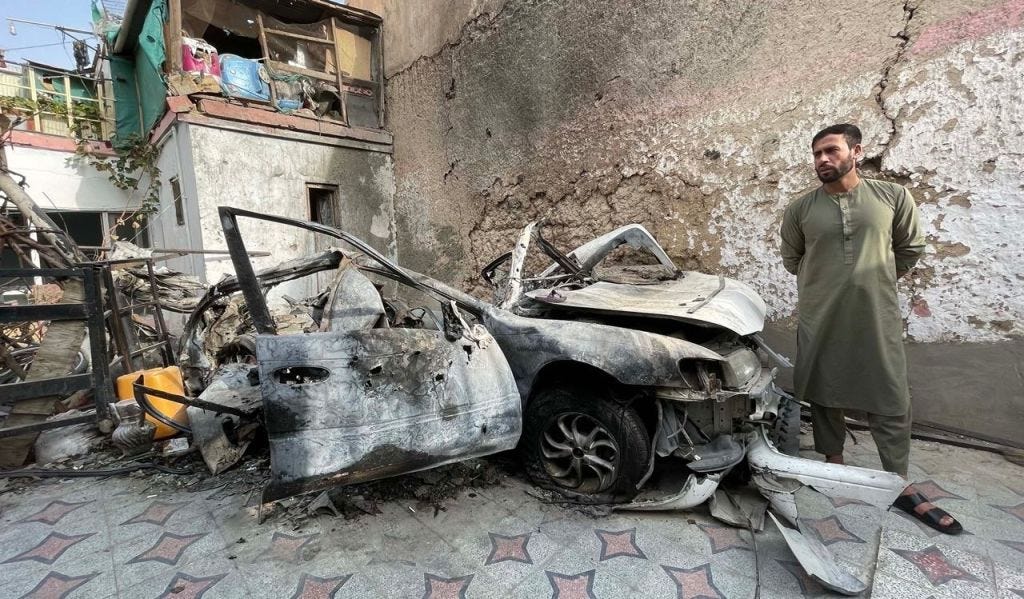This newsletter is going to be just a bit different, especially for a piece so close to Christmas. But it’s about a topic of particular concern, and one that deserves more attention. It’s about our war on terror, how we fought, and why—despite all of our mistakes—our enemies bear the moral responsibility even for most of the innocent civilians who fell to American arms.
I still vividly remember the night I was almost responsible for the deaths of several young boys. It was a terrible night relatively early in my deployment. One of our soldiers had been killed in an IED attack, other soldiers were wounded, and medevac helicopters were on their way.
There was one problem. According to drone footage, a small collection of what appeared to be men were lying in a prone position in a ditch, directly under the flight path of the incoming choppers. We couldn’t see any weapons, but the footage wasn’t sharp, and weapons were easy to hide.
Leave the men alone, and you risked turning a tragedy into a catastrophe, with helicopters shot down and multiple new casualties. Fire on the men with partial information, and you risked killing civilians—but how much risk was there, really? Why would a small collection of men be lying down in a ditch in a prone position after midnight? That looked more like “TTPs” (the military acronym for tactics, techniques, and procedures that mark military activity) than innocent behavior.
There was a third option: We had boots on the ground close by. Send our troops to investigate. But that of course carried its own risks. If they were hostile, there could be a firefight. There could be a suicide bombing.
What do you do? Lives are on the line, including the lives of your brothers in the field.
During our wars in Iraq and Afghanistan, these were exactly the kinds of decisions commanders made, day after day and week after week. And they often did so with someone like me, an Army lawyer, right by their side. We were advisers, not commanders, but our advice carried great weight.
If we recommended against a strike, and a commander overruled us, and the strike proved unjustified, the consequences could be severe. In my entire deployment, I never saw a commander order an attack when his lawyer said wait. If the JAG said yes, on the other hand, commanders rarely said no. After all, they’d rarely even ask if their inclination was to hold fire.
So my commander asked for my counsel. Under the rules of engagement operative at the time, a strike would be lawful. The risk to our troops was profound. Lying prone in a ditch is a classic military tactic. But something felt off, and not just to me. I recommended moving to detain. The commander agreed.
We sent the order and waited:Did we just send our guys into a fight?
Turns out no. Turns out that our instincts were correct. Something was off. Those weren’t men in the ditch. They were a collection of unarmed young teens, middle school-age boys who’d heard a blast, ran out to see what was happening, and hid in the ditch when they got afraid. Hiding almost cost them their lives.
I thought of that moment when I read a remarkable, comprehensive report in the New York Times that attempts to detail the true civilian toll of America’s air wars in Iraq and Syria. I urge you to read the entire thing, but let me summarize: The basic premise is simple to state but remarkably difficult to document—American estimates of civilian casualties in its fight against ISIS are wrong, very wrong. We killed far more civilians than we claim.
Lead reporter Azmat Khan and her team made their case through months of meticulous research. They pored over government documents. They visited the sites of strikes. They interviewed victims. And even if you account for a degree of deception and spin, the conclusions seem inescapable. Our aerial attacks may be precise—the weapons almost always go exactly where they are aimed—but the targeting wasn’t always accurate. In other words, we precisely hit the wrong target.
It’s obvious that the Times expended immense resources on the report. No fewer than 12 people are listed as contributing, and any travel into Syria and Iraq—especially into zones of recent combat—carries real risk. Yet, sadly, I’ve seen too little discussion of its contents, even though it’s directly relevant to understanding how America and its enemies wage war.
I served in Iraq during the height of the surge. You may not remember those days, but war news could and did dominate American headlines. American troop totals alone topped 160,000. Our infantry was locked in daily combat across the length and breadth of Iraq, and we took casualties every day.
We used air power, of course, but my unit, the 2nd Squadron, 3rd Armored Cavalry Regiment, fought up close, on the ground. Our troopers typically saw the enemy directly before they opened fire. Yet even then, despite our best efforts, we inflicted civilian casualties. If you’re fighting in towns and villages against an enemy that intentionally tries to blend in with the population, it’s impossible to get everything right, every time. And even if you’re right, weapons are lethal enough to cause collateral damage.
Now what happens if far fewer boots are on the ground? What happens if even the most advanced surveillance assets in the history of the world are deployed from a distance? What happens if you can’t see inside buildings or the behavior of civilians looks indistinguishable from the behavior of insurgents?
Then innocent people die. By the hundreds. By the thousands.
I wanted to amplify this story for three reasons. The first is obvious—the Pentagon has to be more accurate (or at least less certain) about its damage reporting. I’d forgotten that in April 2016 the Pentagon reported killing 25,000 ISIS fighters and only 21 civilians.
That number was patently absurd. By 2016-2017, the American people were presented with a false picture of modern war that implied we could defeat our enemies not just with minimal toll in American lives but also with a virtually non-existent toll in innocent life.
Yet those of us who’d had experience with targeting operations knew that we could conduct one of the most accurate bombing campaigns in history and still make mistakes. We also knew that the process itself (which tends to trigger investigations only when we become aware of potential problems) lent itself to unquestioned acceptance of initial damage assessments.
In other words, if you think the strike is good, and you see no immediate evidence that it’s bad, you move on to the next target. Your strike can kill the innocent, and you can never know civilians died.
But there are two other points, and they’re both worth emphasizing as well. The primary blame for each of those civilian deaths rests with ISIS, and there are few better alternatives than the tactics we chose.
According to the law of armed conflict (LOAC) combatants are required to distinguish themselves from civilians. It is their obligation to use uniforms or other forms of distinctive insignia. It is their obligation not to use human shields. It is their obligation not to commandeer civilian facilities like hospitals or mosques for military purposes. And if they fail to uphold those obligations, the legal responsibility for the resulting deaths rests with the terrorists.
I’ll give you an example from our own deployment. Mosques were deemed to be “protected” structures. In the absence of military use, they could not be a military target. But one evening in April 2008, al-Qaeda insurgents ambushed our forces, firing from the local mosque. They seriously wounded a soldier. The instant they opened fire, the mosque was a legitimate target, and any damage to the mosque—though inflicted by our weapons—was their responsibility.
Of course the use of civilian facilities or human shields does not convert any given village or town into a free-fire zone, but when I read stories about drone strikes or bombing raids that take innocent lives, in the absence of American negligence or recklessness, I know that the blood of innocents is on ISIS’s hands.
Next, there is no obvious, better path than the path we took. Introducing more American ground troops doesn’t necessarily limit destruction or reduce civilian death. House-to-house urban combat is remarkably destructive. Soldiers who are on the lookout for car bombs, under sniper fire, or fighting room-to-room in occupied buildings will see civilians in the line of fire constantly. It was one of the enduring realities of combat in Iraq.
One of the worst conversations I ever had was with a distraught young man who opened fire on a truck after the truck ignored warnings to slow down or stop and matched the description of truck suspected to carry a bomb. But the driver wasn’t a terrorist. He was a farmer and a father. He died at American hands, but he died because terrorists used civilian trucks and drivers in civilian clothes to create exactly the ambiguities that caused soldiers to hesitate, to wait to pull the trigger until it was too late.
There is no easy way to tighten the rules. Making the rules of engagement ever-more strict costs lives as well. In fact, strict rules of engagement cost me the life of a friend.
It happened on a terrible September night, shortly after I returned home. He was chasing suspected insurgents. They were evading pursuit, but under current rules of engagement, there was no clear and unambiguous justification for opening fire.
So the pursuit continued, until the car was cornered. My friends moved to detain its occupants, but this time they weren’t innocent, and they certainly weren’t kids. A suicide bomber was in the car, and he blew himself up. My friend died. More friends were injured. Had they been able to open fire from a distance, all of them would be alive and intact. Our concern for civilians cost an American life, and his life was far from the only life lost to protect the innocent.
(It would be fascinating to read an equally comprehensive New York Times report highlighting that aspect of our war on terror.)
Moreover, jihadists are aware of our rules. They took advantage of them. In one instance, we watched, aghast, as a terrorist picked up a small child and ran carrying him like a football—all to protect himself from the men he knew had him in their sights. In that instance no one engaged. Even though they technically could have pulled the trigger under the rules of engagement, they just couldn’t bring themselves to fire. Fortunately the man dropped the child, and we later seized the jihadist with no loss of life.
Tighten the rules of engagement too much, and you not only reward your enemy for his lawlessness, you give him an unjustifiable tactical advantage in combat. Loosen the rules excessively and you risk killing so many civilians and causing so much destruction that you fuel the insurgency and create far, far more human suffering than victory requires.
America’s 20-year war on terror is winding down, at least for now. And it’s time to take stock of the lessons learned. Without question we should seek to understand how targeting decisions went awry. Our military should not broadcast false or misleading statistics. Our weapons may be quite accurate, but our intelligence is too often imprecise.
The New York Times report is important. It needs to be read. But when you read it, understand where the true indictment lies. The primary responsibility for civilian death and destruction lies with the terrorists who concealed themselves among the innocent. They used our own laws and values against us as a weapon of war. And when men are that evil, they leave even the most virtuous nations with few good options.
And, by the way, these realities only amplify the dangers of potential human cost of American retreat. Leaving the field of battle increases the chances that terrorists will rise again, that we’ll have to fight again, and if we fight again, there is simply no good way to consistently spare innocent life when the enemy uses civilians as human shields.








Please note that we at The Dispatch hold ourselves, our work, and our commenters to a higher standard than other places on the internet. We welcome comments that foster genuine debate or discussion—including comments critical of us or our work—but responses that include ad hominem attacks on fellow Dispatch members or are intended to stoke fear and anger may be moderated.